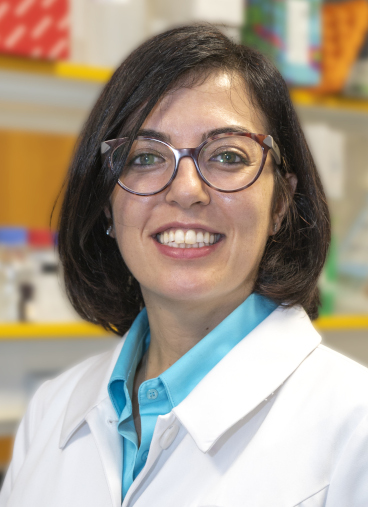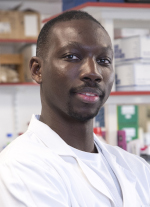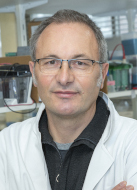 During four days, from 12 to 15th of September, researchers and clinicians of the Institute of Myology will attend the seventh International Congress of Myology, organized by AFM-Téléthon.
During four days, from 12 to 15th of September, researchers and clinicians of the Institute of Myology will attend the seventh International Congress of Myology, organized by AFM-Téléthon.
This renewed international congress brings together around 800 experts in the field of Myology and neuromuscular diseases from all over the world (35 countries). More than 70 international speakers will take the floor during 18 plenary and parallel sessions and more than 400 scientific posters will be discussed during these four days.
Among these, 60 researchers and clinicians from the Institute of Myology, Centre of expertise on muscle and its diseases, will be there to highlight their work and last scientific results in the field of neuromuscular diseases. From fundamental research to therapeutic advances no less than 59 communications (6 oral presentations & 53 posters) will be presented by our neuromuscular scientific experts.
This congress is also the opportunity for Institute of Myology to present its complete environment and activities. From its Center of Research in Myology, its unique Neuromuscular Investigation Center (including 4 labs of excellence) and its clinical activities with two clinical trial platforms – I-Motion – for neuromuscular patients and a dedicated clinical hospital unit, to its ambition to create a future Foundation of Myology, the Institute of Myology is the first Center of this kind for Muscle in its pathologies in France.
Our experts will be happy to welcome you on our booth n°10, in Rhodes exhibition hall, to share discussions all along this congress week.
Among the selected scientific abstracts, six important breakthroughs will be presented to the international community by our researchers:
>> Tuesday, September 13th – Motor neuron diseases (13 PM Parallel 1)

4.30 PM – Piera Smeriglio: The role of DNA epigenetics in modulating Spinal Muscular Atrophy
Spinal muscular atrophy (SMA) is a motor neuron disorder caused by mutation in the SMN1 gene. In human, the presence of the SMN2 paralog can partially compensate for the SMN1 loss and the copy number of SMN2 inversely correlates to disease severity.
We uncovered that DNA epigenetic regulation is altered in human and mouse SMA models, leading to abnormal profile of methylation and hydroxymethylation on the SMN2 gene and genome-wide. These defects promote the aberrant expression of SMN2 and of genes acting on the inflammatory response pathways, suggesting a direct epigenetics role in SMA pathogenesis.

5.20 PM – Giorgia Querin: Spinal cord MRI for early detection of presymptomatic pathology in C9orf72-mutation carriers: a longitudinal neuroimaging study
Amyotrophic Lateral Sclerosis (ALS) and Frontotemporal dementia (FTD) share genetic susceptibility and a large portion of familial cases are due to C9orf72 gene mutations. Brain and spinal cord (SC) imaging studies in asymptomatic C9orf72 carriers have demonstrated white (WM) and grey matter (GM) degeneration up to 20 years before the expected symptom onset.
Objective of this study is to longitudinally analyze cervical spinal degeneration in asymptomatic carriers of the C9Orf72 mutation using different multimodal MRI sequences with the aim of tracking longitudinal degeneration at the spinal level and of identifying possible prognostic factors of disease evolution.
>> Tuesday, September 13th – Development, regeneration & ageing – part 3 (13 PM Parallel 2)

5.00 PM – Alfredo Lopez Kolkovsky: Preliminary results of a multiparametric quantitative NMR ageing study at rest and during exercise in the lower leg in healthy subjects between 20 and 65 years of age
The progressive decline in muscle strength and performance during ageing negatively affects the quality of life in elderly subjects and increases the risk of falls, disability and frailty. The age-related loss of muscle mass, strength and quality is a complex multifactorial process whose mechanisms are incompletely understood.
Nuclear magnetic resonance (NMR) allows evaluating anatomical, structural and physiological aspects of muscle tissue non-invasively in vivo. Functional NMR also enables, for instance, to image during an exercise paradigm the tissue blood flow (BF) or energy metabolism using P MR spectroscopy (MRS).
We designed a protocol where multiple quantitative and complementary measures were performed at rest and during a plantar flexion exercise in 26 subjects. Age-related changes were observed for muscle water T1 relaxation times and muscle fat fraction as well as cellular membrane turnover and mitochondrial stress biomarkers. This study demonstrates the interest of a multiparametric NMR approach in aging studies.

5.45 PM – Massire Traore: Therapeutic approach based on GDF5 to counteract age-related muscle wasting
Sarcopenia is a disease defined as progressive age-related loss of muscle strength, function and mass, which results in increased mortality. Several mechanisms have been proposed to explain the onset and progression of sarcopenia, however, some pathophysiological aspects are still not very well understood and no cure has been established to date.
Our previous work demonstrated that GDF5 (Growth Differentiation Factor 5) overexpression in old mouse prevented muscle mass decline, although a deeper report on the mechanisms and consequences of GDF5 implement on aged muscle was missing. Here, we demonstrate that GDF5 overexpression in muscle during aging induces muscle mass gain and improves neuromuscular connectivity and endplate morphology. In addition, we present the characterization of the cellular and molecular effects of GDF5 in muscle during aging and show its “rejuvenating signature”. Based on this proof of concept, we defined a cutting-edge therapeutic approach describing how the treatment with the recombinant GDF5 protein is able to counteract the age-related skeletal muscle wasting in mice and might have a strong curative potential on humans.
>> Wednesday, September 14th – Myotonic syndromes (14 AM Parallel 1)

10.30 AM – Denis Furling: Decoy gene therapy for Myotonic Dystrophy
Myotonic Dystrophy type 1 (DM1), one of the most common neuromuscular disorders in adults, is characterized by progressive muscle weakness and wasting, myotonia, cardiac defects, endocrine troubles and cognitive impairments. This autosomal dominant disease is caused by an expanded tract of CTG repeats within the 3’ non-coding region of the DMPK gene. Expression of mutant transcripts containing expanded CUG repeats (CUGexp) leads to a toxic RNA gain-of-function mechanism affecting functions of specific RNA binding proteins (RBPs) and consequently, RNA metabolism. To date, there is no cure for DM1 but several therapeutic strategies including small molecule and antisense oligonucleotide approaches are under development.
Here we assessed a gene therapy approach for DM1 using a modified RBP with a high affinity for CUGexp that aims at acting as a decoy and displaces sequestered endogenous MBNL proteins from RNA foci to reverse RNA toxicity. For this purpose, we engineered a truncated MBNL1 protein that keeps its zing finger domains required for the binding to CUGexp but lacks the C-terminal domain involved in splicing activity and homodimerization. Our decoy has a reduced splicing activity but can still compete with MBNL1 for CUGexp-binding. Effect of this decoy was next assessed in both human DM1 muscle cells and HSA-LR mouse model. We showed that the binding of the decoy to CUGexp in DM1 muscle cells allows the release of sequestered endogenous MBNL1 from nuclear foci, restores MBNL1 activity and corrects the transcriptomic signature of DM1. In vivo, local or systemic delivery of the decoy into skeletal muscles of DM1 mice using AAV9 vectors leads to long-lasting correction, up to one year, of both splicing defects and myotonia, hallmarks of DM1. This proof-of-concept study (Arandel et al., Nature Biomedical Engineering, 2022) supports the development of decoy-RBPs with high binding affinities for CUGexp as a therapeutic strategy for DM1.
11.45 AM – Mona Bensalah: Muscle fibrosis: a vicious circle between human fibroadipogenic progenitors and muscle fibers
Fibrosis is described in many organs as an excessive accumulation of extracellular matrix (ECM) proteins that replace tissue and alter its function. In skeletal muscle, fibrosis is a pathological feature common to many dystrophies including Oculopharyngeal Muscular Dystrophy (OPMD), a late-onset disorder, where only a small group of muscles are primarily affected and characterized by an exacerbated fibrosis, fiber atrophy and inflammation. While the cellular and molecular mechanisms regulating muscle fibrosis has been extensively studied in mouse, our understanding of the exact nature and role of mesenchymal cells involved in fibrosis is limited in human and their implication in dystrophic muscle progression remains to be clarified.
We investigated the role and nature of nonmyogenic cells (fibro/adipogenic progenitors, FAPs) from human fibrotic muscles of healthy individuals and OPMD patients, and compared them to nonmyogenic cells from human nonfibrotic muscle. Our data underline the key role of FAPs and their cross-talk with muscle cells through a paracrine signaling pathway in fibrosis of human skeletal muscle, and identify endothelin as a new druggable target to counteract fibrosis.
Beside these six oral presentations, no less than 53 posters will be presented by researchers from the Institute of Myology during break sessions in Rhodes exhibition hall:
• Valérie Allamand : A complex COL6A3 mutation identification: it takes an international village
• Louise Benarroch: Identification of potential genetic modifiers underlying phenotypic variability in a French family with striated muscle laminopathies
• Astrid Brull/Anne Bertrand: miRNA-processing pathway is impaired in skeletal muscle laminopathies
• Enzo Cohen/Valérie Allamand: LOXL4 loss-of-function: a novel cause of matrisome-related disease
• Isabelle Nelson: Solve-RD, solving unsolved cold cases: TTN deletion described thanks to a systematic Copy Number Variant/Structural Variant (CNV/SV) reanalysis
• Mariko Okubo: Gene therapy for striated muscle laminopathy
• Bruno Cadot: From the Muscle Atlas to an AI-based diagnostic tool
• Saline Jabre: Impact of mechanical stretch on nuclear shape and transcription in skeletal muscle
• Delphine Trochet: Benefits of therapy by Dynamin 2 mutant specific silencing are maintained with time in a mouse model of dominant centronuclear myopathy
• Stéphane Vassilopoulos: Caveolae and Amphiphysin 2 form ring-shaped platforms for T-tubule initiation
• Samuel Horita: Laminin-111 derived peptides promote adhesion, proliferation, differentiation and migration of human myoblasts
• Hadidja Rose Mouigni:Control of PABPN1 expression in skeletal muscle
• Laura Muraine: Molecular and cellular actors of human muscle fibrosis in muscular disorders
• Jessica Ohana: Immortalized human muscle cells: easy-to-use models to study neuromuscular diseases
• Charles Frison-Roche: MBNL loss of function in motoneurons leads to motor unit dysfunction in myotonic dystrophy
• Xavière Lornage: MBNL proteins are required for adult skeletal muscle homeostasis and maintenance
• Florent Porquet: Specific DMPK-promoter targeting by CRISPRi reverses DM1-associated defects in patient muscle cells
• Alain Sureau: Development of a new mouse model for Myotonic Dystrophy type 1
• Stéphanie Tomé: Identification of a CCG-enriched expanded allele in DM1 patients using amplification-free long-read sequencing
• Sestina Falcone: Unraveling the role of GDF5 therapeutic potential in Amyotrophic Lateral Sclerosis
• Christel Gentil: GDF5 therapeutic potential for DMD
• Chiara Noviello: Exploring the protective role of GDF5 against skeletal muscle disuse atrophy
• Amélie Vergnol: Role of MuscleBlind-Like proteins in the regulation of expression of CaVβ1 isoforms in adult skeletal muscle
• Marie-Thérèse Daher: An in vitro model to understand the C9orf72-linked Amyotrophic Lateral
• Alexandra Bayer: Immunomodulation capacities of conditioned mesenchymal stromal cells: benefits and mechanisms in an experimental cell therapy approach for Myasthenia gravis
• Edouard Hemery: Sclerosis features in skeletal muscles
• Anne-Charlotte Lefranc: May IL-17 play a role in the pathophysiological events occuring in skeletal muscle in autoimmune MG
• Axel You: Development of a new experimental Myasthenia Gravis mouse model
• Céline Anquetil: Antigenic targets in anti-SRP immune-mediated necrotizing myopathy
• Julian Dal Cin: Description of macrophages in idiopathic inflammatory myopathies using in-situ RNAseq
• Alexandrine Mahoudeau: Myostatin in idiopathic inflammatory myopathies: serum assessment and disease activity
• Stéphanie Godard-Bauché: New mutation in the β1 propeller domain of LRP4 responsible for congenital myasthenic syndrome associated with Cenani-Lenz syndrome
• Caroline Le Dour: Alteration of actin-microtubule cytoskeletal interplay promotes dilated cardiomyopathy caused by LMNA mutations
• Nicolas Vignier: The non-muscle ADF/cofilin-1 controls sarcomeric actin filament integrity and force production in striated muscle laminopathies
• Laura Virtanen: Multimodal Single Cell profiling of Duchenne Muscular Dystrophy
• Marius Halliez : Pathophysiologie de MUSK dans la myasthénie
• Yves Fromes: Cardiac involvement in dystrophinopathies: lessons learned from the canine model
• Benjamin Marty: Quantitative MRI of the dystrophic skeletal muscle in Golden Retriever Muscular Dystrophy dogs
• Benjamin Marty: Quantitative Magnetic Resonance Imaging reveals increased skeletal muscle extracellular volume fraction in patients with Becker muscular dystrophy
• Béatrice Matot: Impact of age on muscle volume and tissue structure during adulthood in mice using quantitative MRI
• Harmen Reyngoudt: Quantitative MRI in lower limb muscles and heart of patients with limb-girdle muscular dystrophy type R9: preliminary results of a natural history study
• Harmen Reyngoudt: Quantitative MRI in skeletal muscle of lower limbs in inclusion body myositis patients treated with rapamycine
• Simone Birnbaum: Exploring barriers and facilitators to exercise in congenital myasthenic syndromes (CMS)
• Simone Birnbaum: Exploring barriers and facilitators to exercise in Lambert-Eaton myasthenic syndrome (LEMS)
• Simone Birnbaum: Facilitators and barriers to exercise in autoimmune myasthenia gravis (MG)
• Valérie Decostre: New exploratory outcome measures in patients with myotonic dystrophy type 1 followed over 36 months
• Audrey El Kaim: Prediction of the 6MWT in Pompe disease
• Romain Feigean: Safety, usability and effectiveness of the MyoSuit, a lightweight wearable lower-limb cable-actuated exoskeleton in patients with neuromuscular disorders: preliminary findings
• Romain Feigean: Safety, usability and efficiency of the Keeogo+, a lightweight wearable powered assistive exoskeleton in patients with neuromuscular disorders: preliminary findings
• Bertrand Fontaine/Stéphane Vasseur: Myobank-AFM, Biological ressources center for research
• Allison Grange: Real life data of the 6-minute walk test in ambulant boys with Duchenne Muscular Dystrophy in France
• Rabah Ben Yaou: OPALE: A patient registry for Laminopathies and Emerinopathies in France
• Bettina Beaujard: L’annonce diagnostique en neuromyologie à travers une méthodologie originale
See the complete program
Download the Institute of Myology press release
